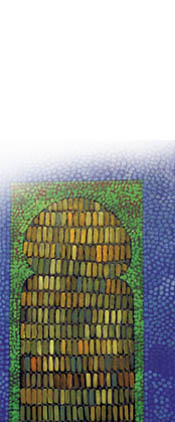
|
 |
This article appeared in Newsline, Karachi, in November 2000.
In Transition
Lubna Agha's work goes through a transition from the amorphous form to tightly structured compositions.
By Niilofur Farrukh
Lubna Agha weaves ornamental motifs into the contemporary pictorial language while addressing concerns of our time in her current work that was on display at Chawkandi Art. Religious icons and corporate logos fuse with timeless decorative patterns that were once eloquent symbols of belief but today serve as metaphors of ethnicity. Traveling globally on the wings of applied arts, these motifs can still be interpreted as ciphers of identity.
The works seem to be in transition as the exhibition showcases two distinct styles, the amorphous naturalistic forms linked to her earlier works like Doli, while the relatively hard-edged, tightly structured compositions stem from her recent experiments with acrylics and share a design response.
References are made to personal experiences and global concerns; the prayer rug, which to her symbolizes the universality of Islam, has been redesigned in her paintings to accommodate logos of economic institutions and multinationals. "Sacred images that we were taught to bow down to have been replaced," says the artist.
Her love for verses mingles with the visual representation of darecha or niche. She uses the mehrab or arch only a diasporist would, laden with nostalgia. For those living in Pakistan, this much-abused symbol of religious architecture has been journeyed into the realm of the hackneyed. In her compositions, when the mehrab adopts a multiple perspective, it evokes architecture reminiscent of Persian miniature painting where pattern and buildings are pivotal to the narrative.
A portrait of a young woman with a part of her brain in deep blue seems to be autobiographical in nature. A conflict surfaces between the logical and the intuitive side as the changing reality dictates hard decisions. The painter allows elements to bleed into each other, forming a landscape of the mind. Trees in the distance are in winter black with roots that lead to arid yellow with a burning red circle.
Decorative patterns repeat themselves along a price bar found on supermarket products. The calibrated window, that is an essential part of computer design software, frames these elements, suggesting a motion that brings them into focus. "I see the process between design and painting going back and forth, with some elements common to both," elaborates Lubna, who is also an established freelance graphic designer in Boston.
The directness of Lubna's design sensibility is most evident in the works like those with the prayer rugs and the White House, where the goal is communications at first glance, tapping into a commonly accessible visualization with little need for introspection.
'The City by the Sea' is an ode to Karachi by one of its daughters. A collapsing city with a meandering stream of blue shows few recognizable structures intact. The diagonal flow of the composition emphasizes a landslide like movement, terminating in rubble. Painted almost completely in flaming red, this highly allegorical work evokes violence and bloodshed, and reminds us of the '90s holocaust in Karachi.
The Lubna Latif of the 70's was an iconoclast who took the Karachi art scene by storm. She confides that Ahmad Pervez was instrumental in opening her eyes to the richness of colour. Lubna had the honour of being invited to exhibit at Zubeda Agha's prestigious Contemporary Art Gallery at Rawalpindi. Her strongest recollection is of the pioneer painter's meticulously neat studio with a spotlessly wiped palette and tidily arranged tubes of paint. Before the coming of age of her talent could be seen in her own country, Lubna left for distant shores to be faced by issues of the diaspora.
In this body of work, she questions the existing language of aesthetics in which traditional beauty or harmony of elements were deconstructed under Modernist philosophies, that not only banished beauty from canvas but relegated it to the non-serious. For the first time in the history of art, this made artists wary of beauty.
Lubna Agha, who has lived in the United States for a few decades and has had extensive exposure to this artistic canon, finds herself instinctively drawn to beauty. "After all, I am a student of Hajra's," says the artist, who studied under this master of Oriental Wash Painting and discipline of Chughtai.
In challenging the established preference for ugliness, Lubna wants to relocate herself in a tradition that cherishes the lyrical use of colour and patterns. Despite the content of social concerns, she would like to make visual statements without harsh abrasiveness and disconcerting distortion.
Trying to find a parallel in the way poets Iqbal and Faiz used the classical literary formats and idiom for new social content, Lubna finds that the strong metaphors in their revolutionary verse retain the lyrical spontaneity of language and exquisite rhythm of the time-honoured beauty of words. This is the inspiration which she would like to transfer to her canvas. With a long way to go, Lubna has elected to go with her instincts and has the confidence to swim against the tide. It will be interesting to see how she grows in this direction.
|
 |
 |


